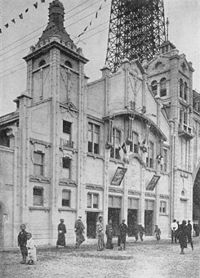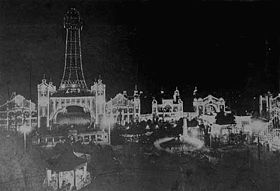- Luna Park, Osaka
-
For other amusement parks known by the same name, see Luna Park.
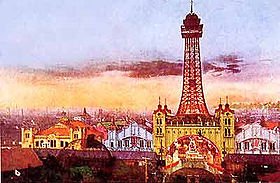 Original Tsutenkaku Tower, with Osaka (Shinsekai) Luna Park in the foreground, ca. 1912. The arch in the right foreground marks the park's main entrance in Shinsekai; the buildings and the tower in the background are in nearby Tsutenkaku.
Original Tsutenkaku Tower, with Osaka (Shinsekai) Luna Park in the foreground, ca. 1912. The arch in the right foreground marks the park's main entrance in Shinsekai; the buildings and the tower in the background are in nearby Tsutenkaku.
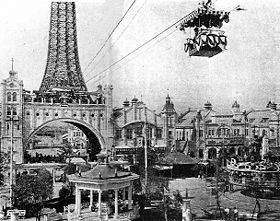 Aerial tramway connecting the original Tsutenkaku Tower with Luna Park, Osaka in Shinsekai, in the 1910s
Aerial tramway connecting the original Tsutenkaku Tower with Luna Park, Osaka in Shinsekai, in the 1910s
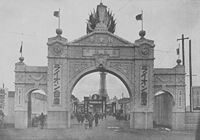 Main entrance of Osaka Luna Park, ca. 1912. The original Tsutenkaku Tower can be seen in the background through the entrance arch.
Main entrance of Osaka Luna Park, ca. 1912. The original Tsutenkaku Tower can be seen in the background through the entrance arch.
Osaka's Luna Park (Runa pāku, also known as Shinsekai Luna Park) was Japan's second amusement park of the same name, replacing the destroyed Luna Park in Tokyo.[1] In operation from 1912 to 1923, the 132,000 square meter[2] park in the Shinsekai section of Osaka featured a unique entrance: an aerial tramway from the original Tsutenkaku Tower.[3][4]
History
The park was constructed and owned by Ken'ichi Kawaura after he sold his interest in the Japanese motion picture company Yoshizawa Shōten to Shōkichi Umeya in the wake of the destruction by fire of Luna Park, Tokyo and two Osaka theaters in 1911. Prior to the suspicious fires, all three were owned by the movie studio.[5]
Rather than rebuilding in Tokyo, Kawaura decided to build his second Luna Park in Shinsekai ("New World"), an Osaka subdivision that was under construction at the time. At the same time, the original Tsutenkaku Tower was being built in nearby Tsutenkaku to the north. Plans were being made to connect the 86 meter[6][7] tower to the park by an aerial tramway to provide visitors a unique "flying sensation" as they entered the park.[8][9]
The Osaka Luna Park featured an arcade, mechanical rides (including one called the Circular Wave, which had seated riders rise and fall as the revolve in a circular motion), a funhouse, a music hall, a theater, and a hot springs spa.[10]
The Osaka Luna Park closed permanently after the 1925 season; in January 1943, the first Tsutenkaku Tower was damaged by a fire and was subsequently closed and demolished by the Japanese government.[11][12] A new Tsutenkaku Tower was built and opened to the public in 1956.[13]
References
- ^ Joseph L. Anderson and Donald Richie, The Japanese Film: Art and Industry (Princeton University Press 1982) ISBN 0691007926
- ^ 2010 NOMS page - IEEE
- ^ History of Shinsekai
- ^ Osaka Journal: Japan’s New World Offers a Slice of the Past - New York Times 15 October 2008
- ^ Volker Grassmuck, Geschlossene Gesellschaft: Mediale und diskursive Aspekte der "drei Öffnungen" Japans English translation
- ^ NOMS 2010 page - IEEE
- ^ Some sources state the height to have been 75 meters
- ^ Sharon Minichiello, Japan's Competing Modernities: Issues in Culture and Democracy, 1900-1930 (University of Hawaii Press 1998) ISBN 0824820800
- ^ Isolde Standish, A New History of Japanese Cinema: A Century of Narrative Film (Continuum International Publishing Group 2006) ISBN 0826417906
- ^ History of Shinsekai
- ^ [http://www.kippo.or.jp/KansaiWindowHtml/News/1996-e/19961105_NEWS.HTML Kippo News, 5 November 1996}
- ^ History of Shinsekai
- ^ Kippo News, 5 November 1996
Categories:- Amusement park stubs
- Japan stubs
- Defunct amusement parks
- Osaka
Wikimedia Foundation. 2010.

